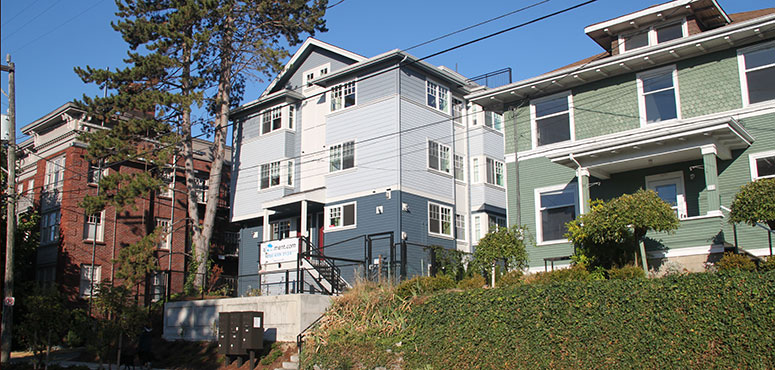
Background
Micro-housing (often referred to as apodments) are small units, which are usually less than 300 square feet in size. They tend to be occupied individually (like studios), but without a kitchen or kitchenette. Units are may be grouped around a common space and share a kitchen with up to 8 other units. Over the past few years, these units began popping up around Seattle and gradually garnering strong and vocal backlash. The units are possible under current zoning because they are considered similar to congregate housing. Examples of congregate-like housing include multiple unrelated people living in a single-family home, assisted living centers, or college dormitories.
The pros
This type of housing provides an option that currently is rarely available in the market place, especially at the price range being targeted. Individuals choosing this option are seeing a number of advantages such as:
- The chance to have a private space without roommates
- The chance to live in a new building
- Costs in high-rent neighborhoods between $500 and $700 a month
- The chance to live closely to a large group of people without the responsibility of cleaning common space
- A standard lease that is legal, ensuring protection under the law rather than depending on unofficial agreements
The cons
Opponents have a large range of complaints, which include common ones like:
- The units will bring unsavory people to the neighborhood
- The increased density will make it harder to find (practically free) street parking
- The buildings are ugly
- No one can/should live in such small spaces
- This isn’t a good solution for cheap housing
The first four complaints are blatantly specious, but have ignited a fire under council to pass regulations that differentiate this type of housing from the single-family homes that are (unofficially) used in the same way already.
Proposed regulations
All of the proposed changes will make it more expensive to build micro-housing. This leads one to ask whether the proposals aim to provide better, more affordable housing or to prevent micro-housing. A few of the regulations that are especially bad:
- Requiring additional parking above and beyond what’s already required
- Putting a minimum size on the kitchen and preventing food prep areas in the individual units
- Requiring a different design review than that required of congregate housing
- Preventing micro-housing in LR2 zones where it is legal to build apartments on a smaller scale
Where we’re at now
During the Planning, Land-Use and Sustainability (PLUS) committee meeting yesterday, a vote was expected on some of the micro-housing rules but instead a decision was made to form a stakeholder group. The stakeholder group will be tasked with determining the best way to regulate this new type of housing. The group will likely consist of about 10 members representing various interest in the debate and will draft new regulations regarding this housing type. It’s hard to say what this means before seeing the make-up of the stakeholder group. With that said, it seems unlikely that the vocal opponents of micro-housing will be the only voice. Additionally, throughout the debate there has been very little influence from people who live in these buildings. Their feedback should prove critical for considering regulation and this will give them a voice.
What the stakeholder group should consider
There’s no doubt that micro-housing isn’t the only, or even the best solution for affordable housing in Seattle. In a perfect world developers would be building units three times the size of micro-housing and charging the same, if not less. In the world we live in, the most affordable, new housing being in Seattle is micro-housing. Any regulations passed should seek to preserve or expand this value. The stakeholder group should consider:
- What regulations can be changed to make micro-housing even more affordable;
- How we ensure that enough micro-housing is built to meet demand; and
- If there are regulations that can make micro-housing more livable without affecting the cost.
We look forward to moving this beyond debate and more thoroughly considering how to structure a city that builds a lot of varied and affordable housing. In the mean time, let’s not kill the projects we are building that are affordable, but instead seek to enhance their value.

Owen Pickford
Owen is a solutions engineer for a software company. He has an amateur interest in urban policy, focusing on housing. His primary mode is a bicycle but isn't ashamed of riding down the hill and taking the bus back up. Feel free to tweet at him: @pickovven.

